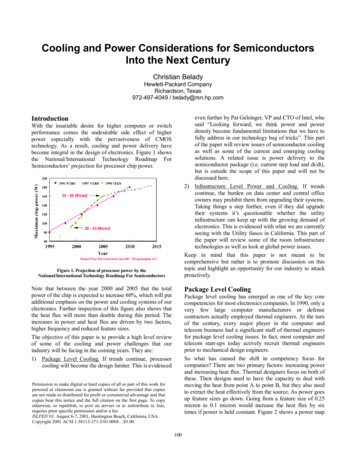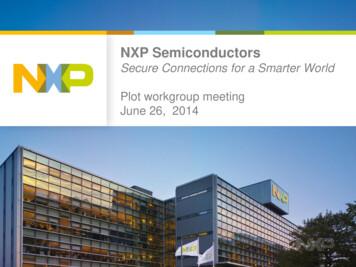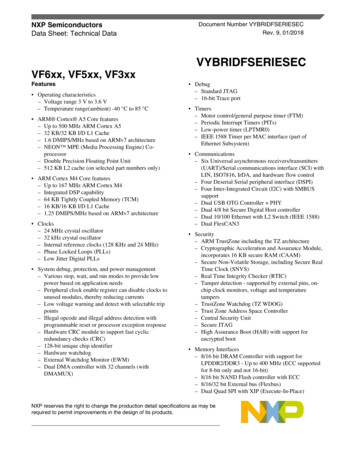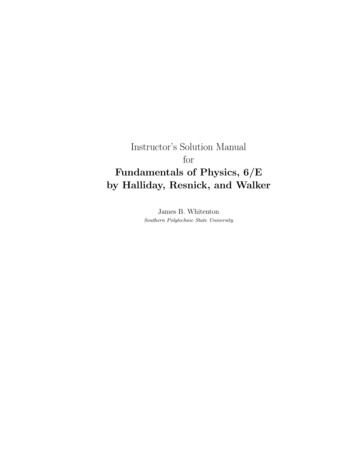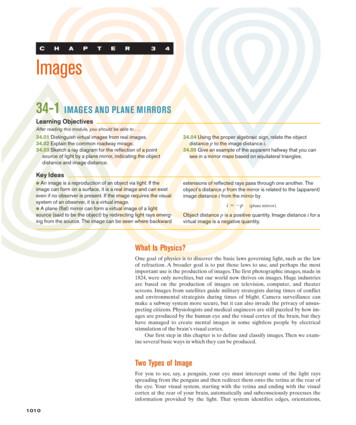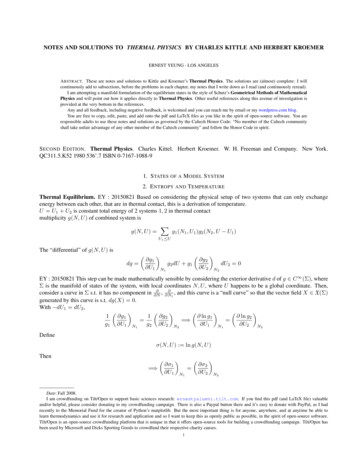Transcription
Graduate Texts in Physics
Graduate Texts in PhysicsGraduate Texts in Physics publishes core learning/teaching material for graduate- andadvanced-level undergraduate courses on topics of current and emerging fields withinphysics, both pure and applied. These textbooks serve students at the MS- or PhD-level andtheir instructors as comprehensive sources of principles, definitions, derivations, experiments and applications (as relevant) for their mastery and teaching, respectively. International in scope and relevance, the textbooks correspond to course syllabi sufficiently to serveas required reading. Their didactic style, comprehensiveness and coverage of fundamentalmaterial also make them suitable as introductions or references for scientists entering, orrequiring timely knowledge of, a research field.Series EditorsProfessor H. Eugene StanleyBoston UniversityCenter for Polymer StudiesDepartment of Physics590 Commonwealth Avenue, Room 204BBoston, MA 02215, USAE-mail: hes@bu.eduProfessor William T. RhodesGeorgia Institute of TechnologySchool of Electrical and Computer EngineeringAtlanta, GA 30332-0250, USAE-mail: bill.rhodes@ece.gatech.edu
Peter Y. YuManuel CardonaFundamentalsof SemiconductorsPhysics and Materials PropertiesFourth Edition123
Professor Dr. Peter Y. YuProfessor Dr., Dres. h.c. Manuel CardonaUniversity of CaliforniaDepartment of PhysicsBerkeley, CA 94720-7300, USAE-mail: pyyu@lbl.govMax-Planck-Institut für FestkörperforschungHeisenbergstr. 1, 70569 Stuttgart, GermanyE-mail: cardona@cardix.mpi-stuttgart.mpg.deISSN 1868-4513ISBN 978-3-642-00709-5DOI 10.1007/978-3-642-00710-1e-ISSN 1868-4521e-ISBN 978-3-642-00710-1Springer Heidelberg Dordrecht London New YorkLibrary of Congress Control Number: 2010924732 Springer-Verlag Berlin Heidelberg 1996, 1999, 2001, 2010This work is subject to copyright. All rights are reserved, whether the whole or part of the material isconcerned, specif ically the rights of translation, reprinting, reuse of illustrations, recitation, broadcasting,reproduction on microf ilm or in any other way, and storage in data banks. Duplication of this publication orparts thereof is permitted only under the provisions of the German Copyright Law of September 9, 1965, inits current version, and permission for use must always be obtained from Springer. Violations are liable toprosecution under the German Copyright Law.The use of general descriptive names, registered names, trademarks, etc. in this publication does not imply,even in the absence of a specif ic statement, that such names are exempt from the relevant protective laws andregulations and therefore free for general use.Printed on acid-free paperSpringer is a part of Springer Science Business Media (springer.com).
Preface to the Fourth EditionSince the appearance of our book, Fundamentals of Semiconductors:Physics and Materials Properties, one of the questions we are askedmost frequently is this: “is there a solution manual to this book?” In preparingthe questions at the end of each chapter we have already tried to guide thereaders to derive the answers by themselves using a step-by-step approach.Clearly this strategy did not work for everyone. We recognize that many ofthe questions in this book are quite challenging and often require reading ofresearch papers to solve them. In response to readers demand we have decided to provide solutions to some of the problems in this new edition. Sinceworking through problems is an important and necessary part of the learningprocess in physics we will not give the solutions to all the problems. Instead,we hope to use the solutions to a number of selected problems in each chapter as an additional study help to the readers. We like to use these solutionsto provide more in depth discussions to topics which may be too specializedfor a typical course on semiconductor physics. By leaving enough unsolvedproblems and adding a few new ones there are still plenty of opportunities forboth the instructors to choose problems for assignments and for students totest their understanding of the text. We like to point out that, even if the solution can be found in this manual, there is usually more than one way to solvea given problem. Conscientious students should always ask whether there is abetter way to solve a problem than the one we have provided in this manual.This new addition also allows us to update and expand some topics andreferences. Finally, we hope to have taken care of the few errors still remaining in the third edition. We like to use this opportunity to thank the readerswho have identified them to us. Their support has been invaluable in our effort to improve this book.A Russian translation of our book has appeared in 2003. It joins previous translations of the book into Japanese and Chinese, making this bookavailable to a truly international readership. Last, but not least, the homepage of the book has been given a ”face lift”. Readers are encouraged tovisit the new website at: to discover new information and materials which have been added.Peter Y. Yu and M. CardonaBerkeley, CA and Stuttgart, GermanyMarch 2010
Preface to the Third EditionThe support for our book has remained high and compliments from readersand colleagues have been most heart-warming. We would like to thank all ofyou, especially the many students who have continued to send us their comments and suggestions. We are also pleased to report that a Japanese translation appeared in 1999 (more details can be obtained from a link on our Website: http://pauline.berkeley.edu/textbook). Chinesea) and Russian translationsare in preparation.Semiconductor physics and material science have continued to prosper andto break new ground. For example, in the years since the publication of thefirst edition of this book, the large band gap semiconductor GaN and relatedalloys, such as the GaInN and AlGaN systems, have all become important materials for light emitting diodes (LED) and laser diodes. The large scale production of bright and energy-efficient white-light LED may one day changethe way we light our homes and workplaces. This development may even impact our environment by decreasing the amount of fossil fuel used to produceelectricity. In response to this huge rise in interest in the nitrides we haveadded, in appropriate places throughout the book, new information on GaNand its alloys. New techniques, such as Raman scattering of x-rays, have givendetailed information about the vibrational spectra of the nitrides, availableonly as thin films or as very small single crystals. An example of the progressin semiconductor physics is our understanding of the class of deep defect centers known as the DX centers. During the preparation of the first edition, thephysics behind these centers was not universally accepted and not all its predicted properties had been verified experimentally. In the intervening yearsadditional experiments have verified all the remaining theoretical predictionsso that these deep centers are now regarded as some of the best understooddefects. It is now time to introduce readers to the rich physics behind thisimportant class of defects.The progress in semiconductor physics has been so fast that one problemwe face in this new edition is how to balance the new information with the oldmaterial. In order to include the new information we had either to expand thesize of the book, while increasing its price, or to replace some of the existingmaterial by new sections. We find either approach undesirable. Thus we havecome up with the following solution, taking advantage of the Internet in thisaThe Chinese version was published in 2002 by Lanzhou University Press (seewww.onbook.com.cn)
VIIIPreface to the Third Editionnew information age. We assume that most of our readers, possibly all, are“internet-literate” so that they can download information from our Web site.Throughout this new edition we have added the address of Web pages whereadditional information can be obtained, be this new problems or appendiceson new topics. With this solution we have been able to add new informationwhile keeping the size of the book more or less unchanged. We are sure theowners of the older editions will also welcome this solution since they canupdate their copies at almost no cost.Errors seem to decay exponentially with time. We thought that in the second edition we had already fixed most of the errors in the original edition.Unfortunately, we have become keenly aware of the truth contained in thistimeless saying: “to err is human”. It is true that the number of errors discovered by ourselves or reported to us by readers has dropped off greatly sincethe publication of the second edition. However, many serious errors still remained, such as those in Table 2.25. In addition to correcting these errors inthis new edition, we have also made small changes throughout the book toimprove the clarity of our discussions on difficult issues.Another improvement we have made in this new edition is to add manymore material parameters and a Periodic Table revealing the most commonelements used for the growth of semiconductors. We hope this book will benot only a handy source for information on topics in semiconductor physicsbut also a handbook for looking up material parameters for a wide range ofsemiconductors. We have made the book easier to use for many readers whoare more familiar with the SI system of units. Whenever an equation is different when expressed in the cgs and SI units, we have indicated in red thedifference. In most cases this involves the multiplication of the cgs unit equation by (4 Â0 ) 1 where Â0 is the permittivity of free space, or the omission ofa factor of (1/c) where c is the speed of light.Last but not least, we are delighted to report that the Nobel Prize inPhysics for the year 2000 has been awarded to two semiconductor physicists,Zhores I. Alferov and Herbert Kroemer (“for developing semiconductor heterostructures used in high-speed- and opto-electronics”) and a semiconductordevice engineer, Jack S. Kilby (“for his part in the invention of the integratedcircuit”).Stuttgart and Berkeley,January 2001Peter Y. YuManuel Cardona
Preface to the Second EditionWe have so far received many comments and feedback on our book from allquarters including students, instructors and, of course, many friends. We aremost grateful to them not only for their compliments but also for their valuable criticism. We also received many requests for an instructor manual andsolutions to the problems at the end of each chapter. We realize that semiconductor physics has continued to evolve since the publication of this book andthere is a need to continue to update its content. To keep our readers informedof the latest developments we have created a Web Page for this book. Its address (as of the writing of this preface) is: http://pauline.berkeley.edu/textbook.At this point this Web Page displays the following information:1) Content, outline and an excerpt of the book.2) Reviews of the book in various magazines and journals.3) Errata to both first and second printing (most have been corrected inthe second edition as of this date).4) Solutions to selected problems.5) Additional supplementary problems.The solutions in item (4) are usually incomplete. They are supposed to serveas helpful hints and guides only. The idea is that there will be enough leftfor the students to do to complete the problem. We hope that these solutionswill satisfy the need of both instructors and students. We shall continue to addnew materials to the Web Page. For example, a list of more recent referencesis planned. The readers are urged to visit this Web Page regularly to find outthe latest information. Of course, they will be welcomed to use this Web Pageto contact us.While the present printing of this book was being prepared, the 1998 International Conference on the Physics of Semiconductors (ICPS) was being heldin Jerusalem (Israel). It was the 24th in a biannual series that started in 1950in Reading (U.K.), shortly after the discovery of the transistor by Shockley,Bardeen and Brattain in 1948. The ICPS conferences are sponsored by the International Union of Pure and Applied Physics (IUPAP). The proceedings ofthe ICPS’s are an excellent historical record of the progress in the field andthe key discoveries that have propelled it. Many of those proceedings appearin our list of references and, for easy identification, we have highlighted inred the corresponding entries at the end of the book. A complete list of allconferences held before 1974, as well as references to their proceedings, can
XPreface to the Second Editionbe found in the volume devoted to the 1974 conference which was held inStuttgart [M. H. Pilkuhn, editor (Teubner, Stuttgart, 1974) p. 1351]. The nextICPS is scheduled to take place in Osaka, Japan from Sept. 18 to 22 in theyear 2000.The Jerusalem ICPS had an attendance of nearly 800 researchers from 42different countries. The subjects covered there represent the center of the current interests in a rapidly moving field. Some of them are already introducedin this volume but several are still rapidly developing and do not yet lendthemselves to discussion in a general textbook. We mention a few keywords:Fractional quantum Hall effect and composite fermions.Mesoscopic effects, including weak localization.Microcavities, quantum dots, and quantum dot lasers.III–V nitrides and laser applications.Transport and optical processes with femtosecond resolution.Fullerites, C60 -based nanotubes.Device physics: CMOS devices and their future.Students interested in any of these subjects that are not covered here, willhave to wait for the proceedings of the 24th ICPS. Several of these topics arealso likely to find a place in the next edition of this book.In the present edition we have corrected all errors known to us at thistime and added a few references to publications which will help to clarify thesubjects under discussion.Stuttgart and Berkeley,November 1998Peter Y. YuManuel Cardona
Preface to the First EditionI, who one day was sand but am today a crystalby virtue of a great fireand submitted myself to the demanding rigorof the abrasive cut,today I have the powerto conjure the hot flame.Likewise the poet, anxiety and word:sand, fire, crystal, strophe, rhythm.– woe is the poem that does not light a flameDavid Jou, 1983(translated from the Catalan original)The evolution of this volume can be traced to the year 1970 when one of us(MC) gave a course on the optical properties of solids at Brown Universitywhile the other (PYY) took it as a student. Subsequently the lecture noteswere expanded into a one-semester course on semiconductor physics offeredat the Physics Department of the University of California at Berkeley. Thecomposition of the students in this course is typically about 50 % from thePhysics Department, whereas the rest are mostly from two departments in theSchool of Engineering (Electrical Engineering and Computer Science; Materials Science and Mineral Engineering). Since the background of the studentswas rather diverse, the prerequisites for this graduate-level course were keptto a minimum, namely, undergraduate quantum mechanics, electricity andmagnetism and solid-state physics. The Physics Department already offers atwo-semester graduate-level course on condensed matter physics, therefore itwas decided to de-emphasize theoretical techniques and to concentrate onphenomenology. Since many of the students in the class were either growingor using semiconductors in device research, particular emphasis was placed onthe relation between physical principles and device applications. However, toavoid competing with several existing courses on solid state electronics, discussions of device design and performance were kept to a minimum. This coursehas been reasonably successful in “walking this tight-rope”, as shown by thefact that it is offered at semi-regular intervals (about every two years) as aresult of demands by the students.One problem encountered in teaching this course was the lack of an adequate textbook. Although semiconductor physics is covered to some extentin all advanced textbooks on condensed matter physics, the treatment rarelyprovides the level of detail satisfactory to research students. Well-establishedbooks on semiconductor physics are often found to be too theoretical by experimentalists and engineers. As a result, an extensive list of reading materialsinitially replaced the textbook. Moreover, semiconductor physics being a mature field, most of the existing treatises concentrate on the large amount of
XIIPreface to the First Editionwell-established topics and thus do not cover many of the exciting new developments. Soon the students took action to duplicate the lecture notes, whichdeveloped into a “course reader” sold by the Physics Department at cost. Thisvolume is approximately “version 4.0” (in software jargon) of these lecturenotes.The emphasis of this course at Berkeley has always been on simple physical arguments, sometimes at the expense of rigor and elegance in mathematics. Unfortunately, to keep the promise of using only undergraduate physicsand mathematics course materials requires compromise in handling specialgraduate-level topics such as group theory, second quantization, Green’s functions and Feynman diagrams, etc. In particular, the use of group theory notations, so pervasive in semiconductor physics literature, is almost unavoidable.The solution adopted during the course was to give the students a “five-minutecrash course” on these topics when needed. This approach has been carriedover to this book. We are fully aware of its shortcomings. This is not too serious a problem in a class since the instructor can adjust the depth of the supplementary materials to satisfy the need of the students. A book lacks suchflexibility. The readers are, therefore, urged to skip these “crash courses”, especially if they are already familiar with them, and consult the references forfurther details according to their background.The choice of topics in this book is influenced by several other factors.Most of the heavier emphasis on optical properties reflects the expertise of theauthors. Since there are already excellent books emphasizing transport properties, such as the one by K. H. Seeger, our book will hopefully help to filla void. One feature that sets this book apart from others on the market isthat the materials science aspects of semiconductors are given a more important role. The growth techniques and defect properties of semiconductors arerepresented early on in the book rather than mentioned in an appendix. Thisapproach recognizes the significance of new growth techniques in the development of semiconductor physics. Most of the physics students who took thecourse at Berkeley had little or no training in materials science and hence abrief introduction was found desirable. There were some feelings among thosephysics students that this course was an easier way to learn about materialsscience! Although the course offered at Berkeley lasted only one semester,the syllabus has since been expanded in the process of our writing this book.As a result it is highly unlikely that the volume can now be covered in onesemester. However, some more specialized topics can be omitted without lossof continuity, such as high field transport and hot electron effects, dynamiceffective ionic charge, donor–acceptor pair transitions, resonant Raman andBrillouin scattering, and a few more.Homework assignment for the course at Berkeley posed a “problem” (excuse our pun). No teaching assistant was allocated by the department to helpwith grading of the problem sets. Since the enrollment was typically over thirtystudents, this represented a considerable burden on the instructor. As a “solution” we provide the students with the answers to most of the questions.Furthermore, many of the questions “lead the student by the hand” through
Preface to the First Editionthe calculation. Others have hints or references where further details can befound. In this way the students can grade their own solutions. Some of thematerial not covered in the main text is given in the form of “problems” to beworked out by the student.In the process of writing this book, and also in teaching the course, wehave received generous assistance from our friends and colleagues. We are especially indebted to: Elias Burstein; Marvin Cohen; Leo Esaki; Eugene Haller;Conyers Herring; Charles Kittel; Neville Smith; Jan Tauc; and Klaus von Klitzing for sharing their memories of some of the most important developments inthe history of semiconductor physics. Their notes have enriched this book bytelling us their “side of the story”. Hopefully, future students will be inspiredby their examples to expand further the frontiers of this rich and productivefield. We are also grateful to Dung-Hai Lee for his enlightening explanationof the Quantum Hall Effect.We have also been fortunate in receiving help from the over one hundredstudents who have taken the course at Berkeley. Their frank (and anonymous)comments on the questionnaires they filled out at the end of the course havemade this book more “user-friendly”. Their suggestions have also influencedthe choice of topics. Many postdoctoral fellows and visitors, too numerous toname, have greatly improved the quality of this book by pointing out errorsand other weaknesses. Their interest in this book has convinced us to continuein spite of many other demands on our time. The unusually high quality of theprinting and the color graphics in this book should be credited to the following people: H. Lotsch, P. Treiber, and C.-D. Bachem of Springer-Verlag,Pauline Yu and Chia-Hua Yu of Berkeley, Sabine Birtel and Tobias Ruf ofStuttgart. Last but not the least, we appreciate the support of our families.Their understanding and encouragement have sustained us through many difficult and challenging moments. PYY acknowledges support from the John S.Guggenheim Memorial Foundation in the form of a fellowship.Stuttgart and Berkeley,October 1995Peter Y. YuManuel CardonaXIII
XIVPreface to the First EditionA SEMI-CONDUCTOR
Contents1.2.Introduction11.12223344455678A Survey of Semiconductors . . . . . . . . . . . . . . . . . . . . . . . . . . . . . . .1.1.1Elemental Semiconductors . . . . . . . . . . . . . . . . . . . . . . . . . .1.1.2Binary Compounds . . . . . . . . . . . . . . . . . . . . . . . . . . . . . . . .1.1.3Oxides . . . . . . . . . . . . . . . . . . . . . . . . . . . . . . . . . . . . . . . . . .1.1.4Layered Semiconductors . . . . . . . . . . . . . . . . . . . . . . . . . . .1.1.5Organic Semiconductors . . . . . . . . . . . . . . . . . . . . . . . . . . . .1.1.6Magnetic Semiconductors . . . . . . . . . . . . . . . . . . . . . . . . . . .1.1.7Other Miscellaneous Semiconductors . . . . . . . . . . . . . . . . .1.2 Growth Techniques . . . . . . . . . . . . . . . . . . . . . . . . . . . . . . . . . . . . . . .1.2.1Czochralski Method . . . . . . . . . . . . . . . . . . . . . . . . . . . . . . .1.2.2Bridgman Method . . . . . . . . . . . . . . . . . . . . . . . . . . . . . . . . .1.2.3Chemical Vapor Deposition . . . . . . . . . . . . . . . . . . . . . . . . .1.2.4Molecular Beam Epitaxy . . . . . . . . . . . . . . . . . . . . . . . . . . .1.2.5Fabrication of Self-Organized Quantum Dotsby the Stranski–Krastanow Growth Method . . . . . . . . . . .1.2.6Liquid Phase Epitaxy . . . . . . . . . . . . . . . . . . . . . . . . . . . . .Summary . . . . . . . . . . . . . . . . . . . . . . . . . . . . . . . . . . . . . . . . . . . . . . . . . . .Periodic Table of “Semiconductor-Forming” Elements . . . . . . . . . . . . . .11131415Electronic Band Structures172.12.22.3182025252.42.5Quantum Mechanics . . . . . . . . . . . . . . . . . . . . . . . . . . . . . . . . . . . . .Translational Symmetry and Brillouin Zones . . . . . . . . . . . . . . . . .A Pedestrian’s Guide to Group Theory . . . . . . . . . . . . . . . . . . . . .2.3.1Definitions and Notations . . . . . . . . . . . . . . . . . . . . . . . . . .2.3.2Symmetry Operations of the Diamondand Zinc-Blende Structures . . . . . . . . . . . . . . . . . . . . . . . .2.3.3Representations and Character Tables . . . . . . . . . . . . . . .2.3.4Some Applications of Character Tables . . . . . . . . . . . . . . .Empty Lattice or Nearly Free Electron Energy Bands . . . . . . . . .2.4.1Nearly Free Electron Band Structurein a Zinc-Blende Crystal . . . . . . . . . . . . . . . . . . . . . . . . . . .2.4.2Nearly Free Electron Energy Bands in Diamond CrystalsBand Structure Calculations by Pseudopotential Methods . . . . . .2.5.1Pseudopotential Form Factorsin Zinc-Blende- and Diamond-Type Semiconductors . . . .2.5.2Empirical and Self-Consistent Pseudopotential Methods303240484852586166
XVIContents2.63.The k·p Method of Band-Structure Calculations . . . . . . . . . . . . . .2.6.1Effective Mass of a Nondegenerate BandUsing the k·p Method . . . . . . . . . . . . . . . . . . . . . . . . . . . . .2.6.2Band Dispersion near a Degenerate Extremum:Top Valence Bands in Diamondand Zinc-Blende-Type Semiconductors . . . . . . . . . . . . . . .2.7 Tight-Binding or LCAO Approach to the Band Structureof Semiconductors . . . . . . . . . . . . . . . . . . . . . . . . . . . . . . . . . . . . . .2.7.1Molecular Orbitals and Overlap Parameters . . . . . . . . . . .2.7.2Band Structure of Group-IV Elementsby the Tight-Binding Method . . . . . . . . . . . . . . . . . . . . . . .2.7.3Overlap Parameters and Nearest-Neighbor Distances . . .Problems . . . . . . . . . . . . . . . . . . . . . . . . . . . . . . . . . . . . . . . . . . . . . . . . . . .Summary . . . . . . . . . . . . . . . . . . . . . . . . . . . . . . . . . . . . . . . . . . . . . . . . . .879496105Vibrational Properties of Semiconductors,and Electron–Phonon Interactions1073.13.24.6869718383Phonon Dispersion Curves of Semiconductors . . . . . . . . . . . . . . .Models for Calculating Phonon Dispersion Curvesof Semiconductors . . . . . . . . . . . . . . . . . . . . . . . . . . . . . . . . . . . . .3.2.1Force Constant Models . . . . . . . . . . . . . . . . . . . . . . . . . . .3.2.2Shell Model . . . . . . . . . . . . . . . . . . . . . . . . . . . . . . . . . . . .3.2.3Bond Models . . . . . . . . . . . . . . . . . . . . . . . . . . . . . . . . . . .3.2.4Bond Charge Models . . . . . . . . . . . . . . . . . . . . . . . . . . . .3.3 Electron–Phonon Interactions . . . . . . . . . . . . . . . . . . . . . . . . . . . .3.3.1Strain Tensor and Deformation Potentials . . . . . . . . . . . .3.3.2Electron–Acoustic-Phonon Interactionat Degenerate Bands . . . . . . . . . . . . . . . . . . . . . . . . . . . . .3.3.3Piezoelectric Electron–Acoustic-Phonon Interaction . . . .3.3.4Electron–Optical-PhononDeformation Potential Interactions . . . . . . . . . . . . . . . . .3.3.5Fröhlich Interaction . . . . . . . . . . . . . . . . . . . . . . . . . . . . .3.3.6Interaction Between Electrons and Large-WavevectorPhonons: Intervalley Electron–Phonon Interaction . . . .Problems . . . . . . . . . . . . . . . . . . . . . . . . . . . . . . . . . . . . . . . . . . . . . . . . . . .Summary . . . . . . . . . . . . . . . . . . . . . . . . . . . . . . . . . . . . . . . . . . . . . . . . . . .135137158Electronic Properties of Defects1594.14.21601611621661714.3Classification of Defects . . . . . . . . . . . . . . . . . . . . . . . . . . . . . . . . .Shallow or Hydrogenic Impurities . . . . . . . . . . . . . . . . . . . . . . . . .4.2.1Effective Mass Approximation . . . . . . . . . . . . . . . . . . . . .4.2.2Hydrogenic or Shallow Donors . . . . . . . . . . . . . . . . . . . .4.2.3Donors Associated with Anisotropic Conduction Bands4.2.4Acceptor Levels in Diamondand Zinc-Blende-Type Semiconductors . . . . . . . . . . . . . .Deep Centers . . . . . . . . . . . . . . . . . . . . . . . . . . . . . . . . . . . . . . . . .110114114114115117121122127130131133174180
Contents4.3.1Green’s Function Methodfor Calculating Defect Energy Levels . . . . . . . . . . . . . . .4.3.2An Application of the Green’s Function Method:Linear Combination of Atomic Orbitals . . . . . . . . . . . . .4.3.3Another Application of the Green’s Function Method:Nitrogen in GaP and GaAsP Alloys . . . . . . . . . . . . . . . .4.3.4Final Note on Deep Centers . . . . . . . . . . . . . . . . . . . . . . .Problems . . . . . . . . . . . . . . . . . . . . . . . . . . . . . . . . . . . . . . . . . . . . . . . . . .Summary . . . . . . . . . . . . . . . . . . . . . . . . . . . . . . . . . . . . . . . . . . . . . . . . . .5.6.183188192197198202Electrical Transport2035.15.2203206206207Quasi-Classical Approach . . . . . . . . . . . . . . . . . . . . . . . . . . . . . . .Carrier Mobility for a Nondegenerate Electron Gas . . . . . . . . . .5.2.1Relaxation Time Approximation . . . . . . . . . . . . . . . . . . .5.2.2Nondegenerate Electron Gas in a Parabolic Band . . . . .5.2.3Dependence of Scattering and Relaxation Timeson Electron Energy . . . . . . . . . . . . . . . . . . . . . . . . . . . . . .5.2.4Momentum Relaxation Times . . . . . . . . . . . . . . . . . . . . .5.2.5Temperature Dependence of Mobilities . . . . . . . . . . . . .5.3 Modulation Doping . . . . . . . . . . . . . . . . . . . . . . . . . . . . . . . . . . . .5.4 High-Field Transport and Hot Carrier Effects . . . . . . . . . . . . . . .5.4.1Velocity Saturation . . . . . . . . . . . . . . . . . . . . . . . . . . . . . .5.4.2Negative Differential Resistance . . . . . . . . . . . . . . . . . . .5.4.3Gunn Effect . . . . . . . . . . . . . . . . . . . . . . . . . . . . . . . . . . . .5.5 Magneto-Transport and the Hall Effect . . . . . . . . . . . . . . . . . . . .5.5.1Magneto-Conductivity Tensor . . . . . . . . . . . . . . . . . . . . .5.5.2Hall Effect . . . . . . . . . . . . . .
in semiconductor physics is our understanding of the class of deep defect cen-ters known as the DX centers. During the preparation of the first edition, the physics behind these centers was not universally accepted and not all its pre-dicted properties
